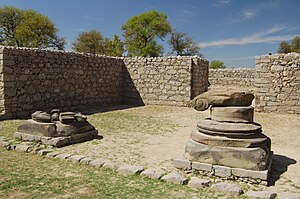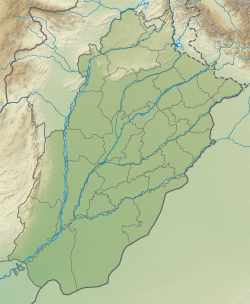Jandial
 Reconstitution  | |
| Coordinates | 33°45′52.1″N 72°49′43.7″E / 33.764472°N 72.828806°E |
|---|---|
| Type | Temple |
| History | |
| Founded | 1st or 2nd century BCE |
| Site notes | |
| Archaeologists | Sir John Marshall |
| Official name | Taxila |
| Criteria | iii, iv |
| Designated | 1980 |
| Reference no. | 139 |
Jandial near the city of
Temple structure
The Temple is considered as a semi-
However, inside the Temple, between the naos and the opisthodomos, there is a heavy wall with stairs, which has led some authors to consider that it was designed to support a
Besides the
Construction


The Ionic capitals of the Jandial temple seem to be a rather provincial and dry version of the Ionic Temple of Artemis in Ephesus.[10] However the design of the bases is quite pure, as are the wall moldings. Also the drums are finely joined with dowels. All this suggests work which was done under Greek supervision, or maybe by Greeks directly.[11]
Dating
The Temple may have been built in the 2nd century BCE under the
Alternatively, it may have been built under the
A coin of the
The Jandial Temple may have been the one visited by Apollonius of Tyana during his visit of the subcontinent in the 1st century CE.[20]
"
Porus. And they saw a Temple, in front of the wall, which was not far short of 100 feet in size, made of stone covered with stucco, and there was constructed within it a shrine, somewhat small as compared with the great size of the Temple which is surrounded with columns, but deserving of notice. For bronze tablets were nailed into each of its walls on which were engraved the exploits of Porus and Alexander."— "Life of Appolonius of Tyana", Philostratus 2.16-20[21]
Gallery
-
Survey of 1912–13. Remnants of additional pillars can be seen in the front.
-
Survey of 1912–13. Decorative details are visible on the capital.
-
Jandial is located just to the north of Sirkap.
Jandial D
On another mound (Mound D),a little to the west of Jandial, foundations of another temple (Jandial D) which may have been built in the 2nd century BCE under the Greeks as well, were excavated in 1863–64.[22] The temple which has a plan very similar to Jandial had a large front porch measuring 58 feet. Between Jandial and Jandial D ran most probably the ancient high-road to Gandhara.[23]
Sources
- "Notes on Ionic Architecture in the East" Benjamin Rowland, Jr., American Journal of Archaeology, Vol. 39, No. 4, pp. 489–496 Published by: Archaeological Institute of America [24]
External links
References
- ^ "The Hellenistic Settlements in the East from Armenia and Mesopotamia to Bactria and India" Getzel M. Cohen, Univ of California Press, 2013, p.327 [1]
- ^ "The Dynastic Arts of the Kushans", John M. Rosenfield, University of California Press, 1 janv. 1967 p.129 [2]
- ^ "The Hellenistic Settlements in the East from Armenia and Mesopotamia to Bactria and India" Getzel M. Cohen, Univ of California Press, 2013, p.327 [3]
- ^ Rowland, p.492
- ^ "The Hellenistic Settlements in the East from Armenia and Mesopotamia to Bactria and India" Getzel M. Cohen, Univ of California Press, 2013, p.327 [4]
- ^ "The Grandeur of Gandhara: The Ancient Buddhist Civilization of the Swat, Peshawar, Kabul and Indus Valleys" Rafi U. Samad, Algora Publishing, 2011 p.62 [5]
- ^ "Papers on the Date of Kaniṣka" Arthur Llewellyn Basham, Brill Archive, 1969, p.23 [6]
- ^ Rowland, p.495
- ^ Rowland, p.496
- ^ Rowland, p.492
- ^ Rowland, p.493
- ^ "The Grandeur of Gandhara: The Ancient Buddhist Civilization of the Swat, Peshawar, Kabul and Indus Valleys" Rafi U. Samad, Algora Publishing, 2011 p.62 [7]
- ^ "Papers on the Date of Kaniṣka" Arthur Llewellyn Basham, Brill Archive, 1969, p.23 [8]
- ^ "The Grandeur of Gandhara: The Ancient Buddhist Civilization of the Swat, Peshawar, Kabul and Indus Valleys" Rafi U. Samad, Algora Publishing, 2011 p.62 [9]
- ^ Rowland, p.491
- ^ "The Hellenistic Settlements in the East from Armenia and Mesopotamia to Bactria and India" Getzel M. Cohen, Univ of California Press, 2013, p.327 [10]
- ^ Rowland, p.493
- ^ Rowland, p.495
- ^ Rowland, 494
- ^ Rowland, p.494
- ^ Philostratus, Life of Apollonius 2.16-20
- ^ Sir John Marshall: A Guide to Taxila, p.89. Cambridge 1960
- ^ Sir John Marshall: A Guide to Taxila, p.85. Cambridge 1960
- ^ Notes on Ionic Architecture in the East






